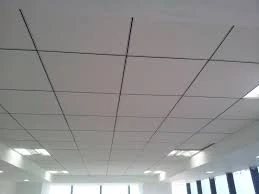- Afrikaans
- Albanian
- Amharic
- Arabic
- Armenian
- Azerbaijani
- Basque
- Belarusian
- Bengali
- Bosnian
- Bulgarian
- Catalan
- Cebuano
- Corsican
- Croatian
- Czech
- Danish
- Dutch
- English
- Esperanto
- Estonian
- French
- German
- Greek
- Hindi
- Indonesian
- irish
- Italian
- Japanese
- Korean
- Lao
- Malay
- Myanmar
- Norwegian
- Norwegian
- Polish
- Portuguese
- Romanian
- Russian
- Serbian
- Spanish
- Swedish
- Thai
- Turkish
- Ukrainian
- Uzbek
- Vietnamese
Th10 . 22, 2024 08:54 Back to list
Exploring the Design and Functionality of Ceiling T Grid Systems in Modern Architecture
Understanding Ceiling T Grids An Essential Component of Contemporary Architecture
Ceiling T grids, often simply referred to as T-bar grids or drop ceilings, play a pivotal role in modern architectural design, particularly in commercial and industrial spaces. This system consists of a framework of aluminum or steel strips arranged in a grid pattern, which supports ceiling tiles or panels. The purpose of these grids extends beyond mere aesthetics; they contribute to functionality, acoustics, insulation, and ease of access to the infrastructure above.
Design and Functionality
One of the primary advantages of ceiling T grids is their versatile design. They can be tailored to fit various architectural styles, accommodating anything from a sleek, modern office layout to a more traditional building. The grids can be installed at different heights, allowing architects to create visual interest and manipulate space perception.
In terms of functionality, T grids provide an easy way to install and maintain ceiling tiles. The grid system allows for quick access to wiring, plumbing, and HVAC systems hidden above the ceiling. If maintenance is required, individual tiles can be removed and replaced without disrupting the entire ceiling, making them a practical choice for busy environments.
Acoustic Performance
Another significant benefit of ceiling T grids is their impact on acoustics. In spaces like open-plan offices, schools, and auditoriums, sound control is crucial. The materials used in ceiling tiles can absorb sound, reducing reverberation and creating a more pleasant acoustic environment. This is particularly important in areas where multiple conversations occur simultaneously, as it helps minimize distractions and enhances overall productivity.
Ceiling T grids combined with acoustic tiles effectively manage noise levels, catering to the needs of various environments. For instance, in a restaurant setting, a well-designed ceiling can help keep the noise at a manageable level, allowing patrons to converse comfortably.
Insulation and Energy Efficiency
ceiling t grid

Beyond acoustics, ceiling T grids also play a role in thermal insulation. Ceiling tiles can enhance a building's overall energy efficiency by providing an additional layer of insulation. This helps in maintaining a consistent indoor temperature, reducing the strain on heating and cooling systems, and ultimately lowering energy bills. In commercial buildings, where energy expenses can be significant, this feature can lead to considerable cost savings in the long run.
Aesthetic Appeal
Aesthetically, T grids offer a clean, uniform look that complements a wide array of design themes. They come in various finishes and colors, allowing for personalization to match the decor of any space. Whether in a corporate office, a healthcare facility, or a retail store, ceiling grids can enhance the visual appeal of a room. Moreover, the ability to integrate lighting fixtures and other elements into the grid system can further elevate the design.
Installation Process
The installation of ceiling T grids is relatively straightforward, making it a popular choice for contractors and builders. The process begins with measuring the space and determining the layout of the grid. Once the framework is secured to the ceiling, tiles are fitted into the grid. This simplicity not only accelerates the construction timeline but also reduces labor costs.
Sustainability Considerations
As sustainability becomes an increasingly important aspect of construction, ceiling T grids can also contribute to greener building practices. Many manufacturers offer tiles made from recyclable materials or those that meet specific energy-efficient standards. By choosing sustainable options, architects and builders can reduce the environmental impact of their projects.
Conclusion
In conclusion, ceiling T grids are an essential component of modern architecture, offering numerous benefits that contribute to the functionality, aesthetics, and sustainability of a space. Their versatile design, acoustic management, energy efficiency, and ease of installation make them a preferred choice for builders and designers alike. As architectural trends continue to evolve, the role of ceiling T grids will undoubtedly remain significant in shaping the spaces we inhabit.
-
Transform Interiors with PVC Gypsum Ceiling: A Stylish, Durable, and Moisture-Resistant SolutionNewsMay.19,2025
-
The Smart Interior Upgrade: Discover the Durability and Versatility of Gypsum Ceiling Access Panel SolutionsNewsMay.19,2025
-
The Smart Choice for Interior Design: Discover the Value of PVC Gypsum Ceiling SolutionsNewsMay.19,2025
-
Mineral Fiber Ceiling Tiles: The Smart Blend of Performance and AestheticsNewsMay.19,2025
-
Mineral Fiber Ceiling Tiles: The Superior Choice Over Gypsum for Sound and Fire SafetyNewsMay.19,2025
-
Mineral Fiber Ceiling Tiles: Eco-Friendly Strength and Style for Every CeilingNewsMay.19,2025







